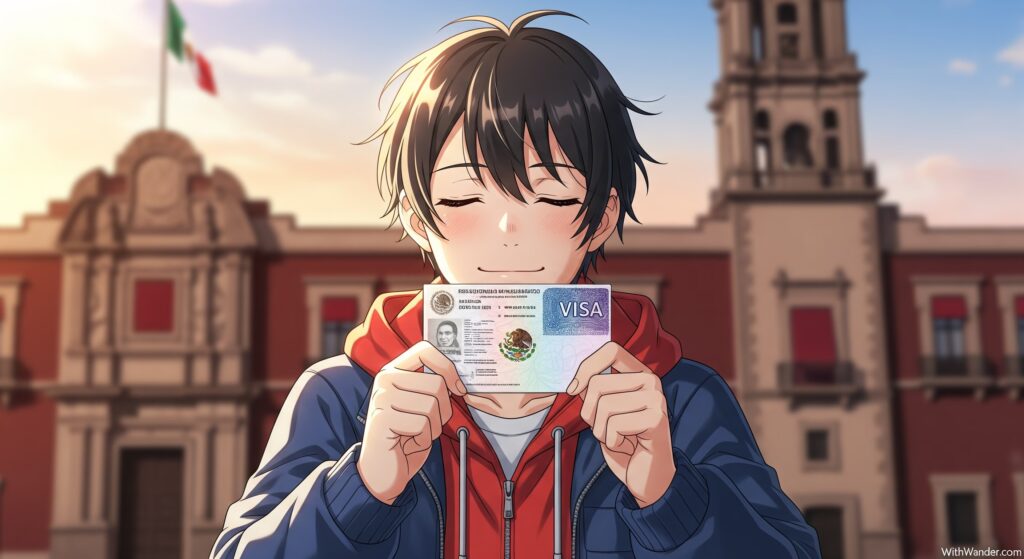INDEX
I’ve seen the videos online. People landing in Cancún, getting a 180-day stamp without a second glance, and heading straight to a coworking space.
That was the old way.
The reality of trying to work remotely Mexico tourist visa now requires more planning.
Mexico is still one of the best places for remote workers, but the days of assuming a six-month stay are over.
This guide is based on my own entries and those of fellow travelers, giving you the practical, non-glamorized truth for 2025.
The Honest Truth About How to Work Remotely Mexico Tourist Visa

First, let’s clear up the main point of confusion.
What most people call a “tourist visa” isn’t a visa sticker in your passport.
It’s a visitor’s permit, or FMM (Forma Migratoria Múltiple), that you get upon arrival.
For years, getting 180 days on this FMM was almost automatic.
Now, it’s entirely at the discretion of the immigration agent you speak with.
You might get 180 days, or you might get 15.
This uncertainty is the biggest challenge for remote workers.
As of 2025, Mexico has been phasing out paper FMM forms and replacing them with passport stamps or digital versions at many airports and land borders.
⚠️The 180-Day Myth Advisory
Do not book a six-month apartment before you have your FMM in hand. Many travelers are now receiving 30, 60, or 90 days. Your entry duration is not guaranteed.
Source: Personal experience at CUN and MEX airports (2023-2025)
This shift means you must arrive prepared to justify the time you’re requesting as a tourist.
Never mention work.
Your goal is to be a well-prepared visitor.
Is Remote Work in Mexico Actually Legal?

The short answer is no.
If you want the official, black-and-white rule, you cannot legally work in Mexico on an FMM tourist permit.
This permit is strictly for tourism, transit, or certain business activities that don’t involve payment in Mexico.
However, there is a massive gray area that thousands of remote workers operate in.
The key distinction is who pays you.
Working for a Mexican company is illegal.
Working remotely for a company in your home country (or anywhere outside Mexico) is widely practiced and generally tolerated.
Immigration is more concerned with people taking jobs from Mexican citizens, not those spending foreign-earned money in the local economy.
This practice is very common, especially in nomad hubs.
You are spending foreign currency, which helps local cafes, shops, and landlords.
Officials rarely ask about remote work unless you give them a reason to be suspicious.
It’s a “don’t ask, don’t tell” situation for most people.
Technically, you are violating the terms of your tourist FMM.
There’s a small risk of being denied entry if you admit to working.
You have no legal labor protections within Mexico.
This is not a long-term solution for permanent residency.
How Long Can Americans Stay in Mexico? The FMM Gamble

For Americans and citizens of many other countries, the maximum possible stay on an FMM is 180 days.
But as I’ve said, this is not a guarantee.
The number written on your FMM by the agent is the only one that matters.
I’ve found that a few key factors influence the agent’s decision.
They want to see that you are a genuine tourist with a clear plan and the means to support yourself without working illegally.
Have a flight out of Mexico booked and ready to show.
Airlines might demand this before you even board your flight.
Even a cheap bus ticket to the US or Guatemala border can work.
This is the strongest proof you intend to leave.
Print your booking for at least the first week.
An Airbnb or hotel confirmation shows you have a solid plan.
Saying “I’ll figure it out” looks unprepared and can raise flags.
Have the address and name of the place handy.
You probably won’t be asked, but be prepared.
A digital or printed copy of a recent bank statement is good.
It proves you can pay for your trip without working locally.
No need to volunteer this info, just have it as backup.
3 Tested Hacks for a Longer Stay

After a few entries and talking with dozens of others, I’ve found three reliable strategies.
The first is about preparation, the second is an alternative entry method, and the third is the long-term legal route.
Hack 1: The ‘Polite & Prepared’ Entry Strategy

This is the most important one.
Confidence and preparation make a huge difference. Don’t look nervous, and have your documents in order.
What to Prepare Before You Fly
Being a serious traveler starts before you even pack, from preparing house for long trip to organizing your documents.
I keep a small folder with printouts.
WiFi can be spotty, and fumbling with your phone looks disorganized.
Being ready shows you are a serious traveler.
Your flight ticket out of Mexico, printed.
First week accommodation booking, printed.
A copy of a recent bank statement, just in case.
Your passport, of course!
Have a simple tourist itinerary in your head.
“I’m visiting Mexico City, then Oaxaca, then the coast.”
Mention specific sights like museums or ruins if you can.
This shows you’re here for legitimate tourism.
What to Say (and Not Say) to the Agent
Your conversation with the agent will be short. Be polite, direct, and answer only what they ask.
💡Immigration Agent Script
When the agent asks about your trip’s purpose, be clear: “For tourism.” If they ask how long, state the time you want confidently: “I’d like to stay for 180 days to travel the country.” Never use the words “work,” “remote,” or “digital nomad.”
Hack 2: Consider a Land Border Crossing

While airports are getting stricter, I’ve found some land borders can be a bit more straightforward, though this is not a guarantee.
The process is different.
You often have to park your bus or car and walk into the INM (immigration) office yourself to get processed. This is especially relevant if you have a detailed cross country road trip plan.
If you don’t actively get your FMM and stamp, you will be in the country illegally.
This is a more formal and streamlined process.
Agents are trained to spot inconsistencies in travel plans.
Your return ticket is almost always checked by the airline.
Scrutiny is generally higher than at land borders.
You must be proactive to find the INM office and get your stamp.
Sometimes feels more relaxed, but rules are the same.
They might ask fewer questions about onward travel.
I did this from Chetumal and found it very efficient.
Hack 3: The Temporary Resident Visa Path

If Mexico becomes one of your returning to favorite travel places and you plan to stay for more than six months, stop doing visa runs.
The correct and legal way is to apply for a Temporary Resident Visa.
This allows you to stay for one year and can be renewed for up to four.
The key requirement is proving financial solvency.
You must show a minimum monthly income or savings balance over a specific period. This level of long-term commitment also means sorting out other logistics, like finding the right insurance for quitting job travel.
This process starts at a Mexican Consulate OUTSIDE of Mexico.
Financial solvency is the most important part of the application.
As of 2025, most consulates require approximately $4,100-$4,200 USD monthly income for 6 months or $68,000-$70,000 USD in savings for 12 months.
Amounts change; check your local consulate’s site for exact figures.
Find official consulate info via the Secretaría de Relaciones Exteriores.
You get an appointment and submit documents at the consulate.
If approved, you get a visa sticker in your passport.
You then have 180 days to enter Mexico.
Once in Mexico, you finalize the process to get your residency card within 30 days.
Does Having Another Visa Affect Mexico Entry?

This question comes up a lot.
For U.S. citizens, it’s not relevant since they can enter Mexico without a visa.
But for other nationalities, it’s very important.
Mexico allows visa-free entry for tourism to people who hold a valid, multiple-entry visa for the United States, Canada, Japan, the United Kingdom, or any country in the Schengen Area.
🌍Visa Equivalency Perk
If your nationality normally requires a Mexican visa, but you have a valid US B1/B2 visa, for example, you can enter Mexico with it. This is a huge benefit for many travelers. Always double-check the rules for your specific passport on the official Mexican consulate website.
FAQs: Your Questions on Working Remotely in Mexico

Here are quick answers to the most common questions I get.
Can I work on a Mexico tourist visa?
Officially, no. The FMM is for tourism. However, working for a foreign company while in Mexico is a common gray area that is widely practiced by many remote workers.
What happens if I only get 30 days on my FMM?
Your options are to enjoy a shorter trip, or to leave the country (a “visa run”) and try re-entering. A visa run does not guarantee you will get more days on your next entry and can be risky if you try it too many times.
Is it better to apply for a Temporary Resident Visa from my home country?
It is the only way. The Temporary Resident Visa application process must be started and approved at a Mexican consulate located outside of Mexico. You cannot change from a tourist FMM to a resident visa from within the country. Mexico remains an incredible place for remote workers. The culture, food, and people are second to none. The entry process has just become less of a rubber stamp and more of a formal procedure. Arrive polite, prepared, and with a clear tourist plan, and you will set yourself up for the best possible start to your time here.
What are the most important documents to have ready for immigration?
You should have printed copies of your flight ticket out of Mexico, your accommodation booking for at least the first week, and a recent bank statement to prove sufficient funds. Having these documents organized shows you are a prepared tourist.
Should I tell the immigration agent that I am a digital nomad?
Absolutely not. The guide is very clear that you should never use the words “work,” “remote,” or “digital nomad.” Your stated purpose for visiting must always be “tourism.” Mentioning work can lead to being denied entry.
Can I extend my FMM tourist permit from inside Mexico?
No, you cannot extend an FMM tourist permit from within Mexico. If you receive a shorter stay than you hoped for, your only option is to leave the country and attempt to re-enter (a “visa run”), but this does not guarantee you will get more days on your next entry.
Do I still need to get an FMM if I cross into Mexico by land?
Yes. It is critical that you are proactive at land borders. You must find the INM (immigration) office, present your passport, and get your FMM with an official entry stamp. Failing to do this means you are in the country illegally.
My passport requires a visa for Mexico, but I have a US visa. Can I enter?
Yes, in most cases. Mexico allows visa-free entry for tourism if you hold a valid, multiple-entry visa from the United States, Canada, Japan, the United Kingdom, or a Schengen Area country. Always check the official consulate website for rules specific to your nationality.
